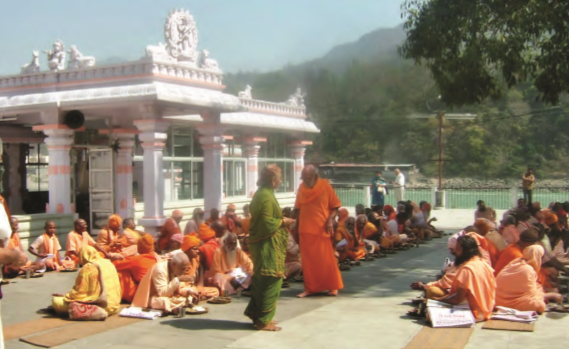Indian Ashrams
India & You
November-December 2016

India has always been known as the home of spirituality and mysticism to visitors from all over, especially the foreigners, and sustaining this image are the humble ashrams.
Ashrams or spiritual homes in India are slowly becoming destinations for tourists from across the globe. Whether under the banner of large scale organisations or individual facilities, these spaces become a solace for seekers of wellness who gain an insight into eastern philosophy and spirituality with a lifestyle incorporating healthy eating practices and Yoga.
There are ashrams in the quiet Himalayas and warm beaches by the ocean where connectivity to the outside world remains cut off but looking inwards becomes the focus. At the same time, ashrams are sprawling the locales of big cities as an experience in finding the center of calm amidst the bustling crowds. The increasing number of ashrams in the west are contributing to the growing shift in exploring the options of staying in one during travel, or perhaps changing the purpose of travel itself.
North to South
Rishikesh, located in the North Indian state of Uttarakhand, remains a top choice for those coming to India to stay in ashrams. With a number of independent individual ashrams, which have been around for more than a few decades, or even hundreds of years, it is almost inevitable that a first-time ashram visitor to India would end up at the beautiful hill station by the river Ganges. Ashrams like the Rama Sadhaka Grama Ashram, the Swami Dayananda Saraswati Ashram and Phool Chatti Ashram see a large turnout of visitors to the region.
Whether it is the Auroville, in the Union Territory of Pondicherry, which is an international community, or the more discrete Sri Ramana Ashram Tiruvannamalai, close to Chennai, the capital of Tamil Nadu, at the southern part of India, is sprawling with ashrams which are holiday destinations for some and for the others eventually become home.
Gretta Spalke, student of philosophy from Germany said, “I have been visiting Auroville for three years now. In conventional terms, it is not an ashram per se but the little home of people living in the community, with daily meditation classes and some Yoga, this place has become like my second home. It shelters me from the madness of the world outside and also offers a chance for me to get to connect with my inner self.”
International Society for Krishna Consciousness (ISCKON) has had a longstanding relation with visitors from abroad, since its establishment in 1966 at New York City, in the US. With Hare Krishna chants being echoed through the day and a pure vegetarian diet, stays at their ashrams across the country, from Vrindavan in Uttar Pradesh to Mayapur in West Bengal, become a rejuvenating experience for visitors. Although most ashrams are restricted to male devotees, a few are open for women and guesthouses in the temple complex are also available.
Changing city life
People often associate the ashram life with quaint homes located in secluded places, far away from the urban bustle. However, big cities in India are all home to major ashrams, which are largely frequented by visitors from abroad.
The iconic Osho Ashram in Pune is one such place, and The Yoga Institute in Mumbai is another, both located in the western state of Maharashtra. Cities like Bangalore, in the southern state of Karnataka and New Delhi, the national capital, are also homes to major Sri Aurobindo ashrams, which remain booked throughout the year.
For high-standard facilities which include a swimming pool and sauna, the Osho ashram is a good place to go. Although the prices may suit heavy spenders, the atmosphere of the ashram is thoroughly enjoyed by visitors who get to indulge in meditation programmes and wellness workshops.
Clemence, a traveller and Yoga enthusiast from France, came to Mumbai not just seeking to escape the drill of the city life but also embrace it with a balanced mind. “The fact that I am residing in The Yoga Institute, in an ashram inside the city, makes me realise that the mental wellness exercises we practice here can easily be incorporated into our daily lives back home in Europe.” The Yoga Institute is reportedly the oldest organised Yoga centre in the world, whose residential programmes range from a seven days life course to 21 days to understand better living.
An exercise in self exploration
Daily life in an ashram can be packed with activities- Yoga classes, group meditation sessions, philosophy lectures, satsang or gatherings – as a part of their schedule. Cooking and cleaning can also be an integral part of the daily experience, aimed to generate a connection to one’s own everyday experiences in life, and as a form of appreciating the value of these seemingly mundane activities through their practice.
Living in an ashram thus can turn into an educational experience. Some even choose to club ashram living with internationally recognised Yoga teacher certification courses. Going back home with a license to share their knowledge on Yoga and eastern philosophies, such visitors are growing by the year.
Expanding boundaries
Ashrams have moved beyond India and are sprouting across Europe. Big foundations have established centres in Europe and the US, among other places, and these serve as retreats for those unable to make the journey to the Indian subcontinent. Mostly founded as Yoga schools, these ashrams offer retreats and lessons. The Integral Yoga Europe has centres and teachers in Portugal, Spain, Italy and France, among other countries. With Sivananda ashrams also popping up in places like Chicago in the US and Italy, France and Spain in Europe, the ashram culture emerging from India is reaching out to and captivating the world.
Ashrams, as destinations and places of visit, are increasingly becoming an important aspect of the wellness tourism industry that travellers are exploring. Simple living involving mindfulness and a relaxed approach to understanding one’s inner self, keep bringing the travellers back.









